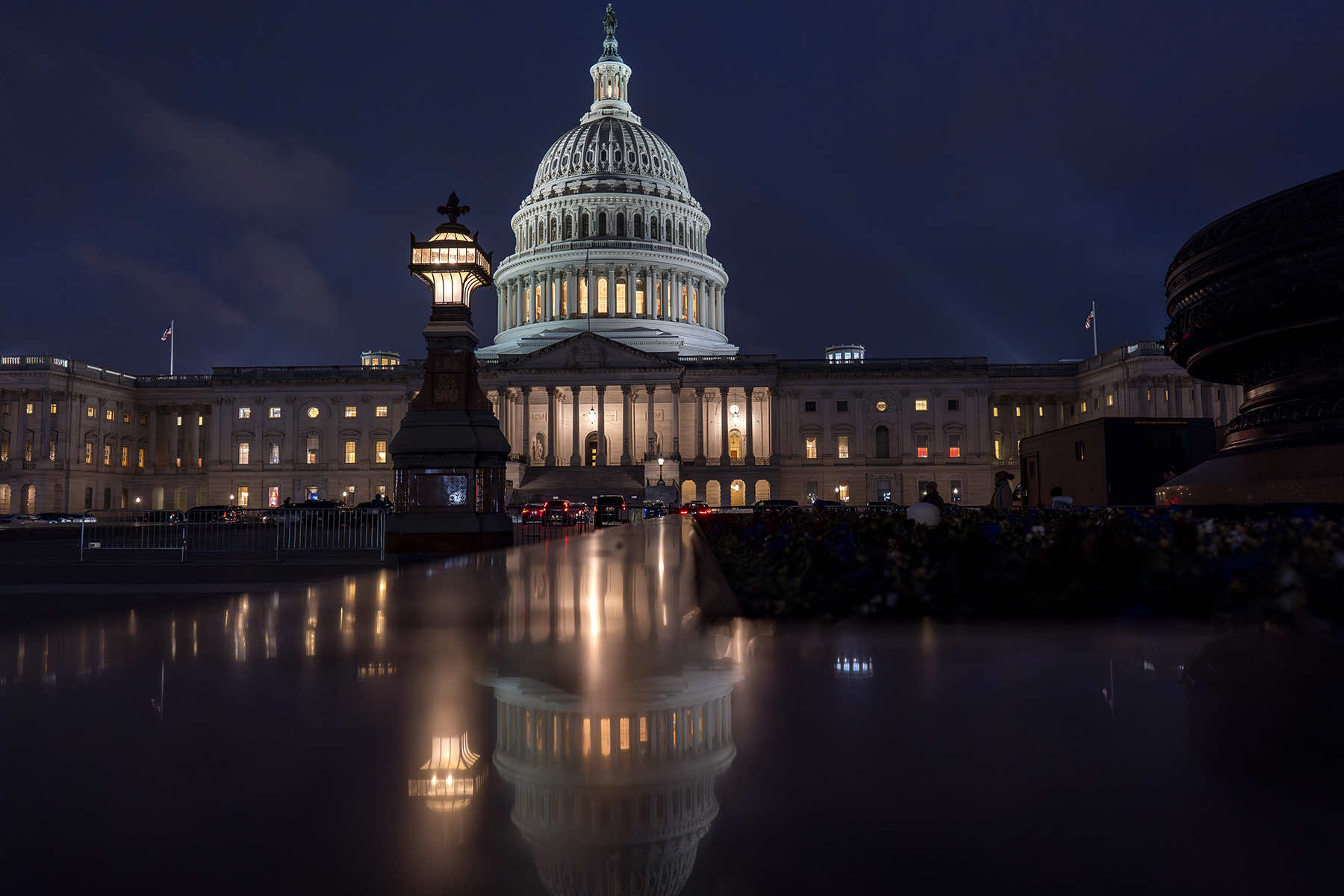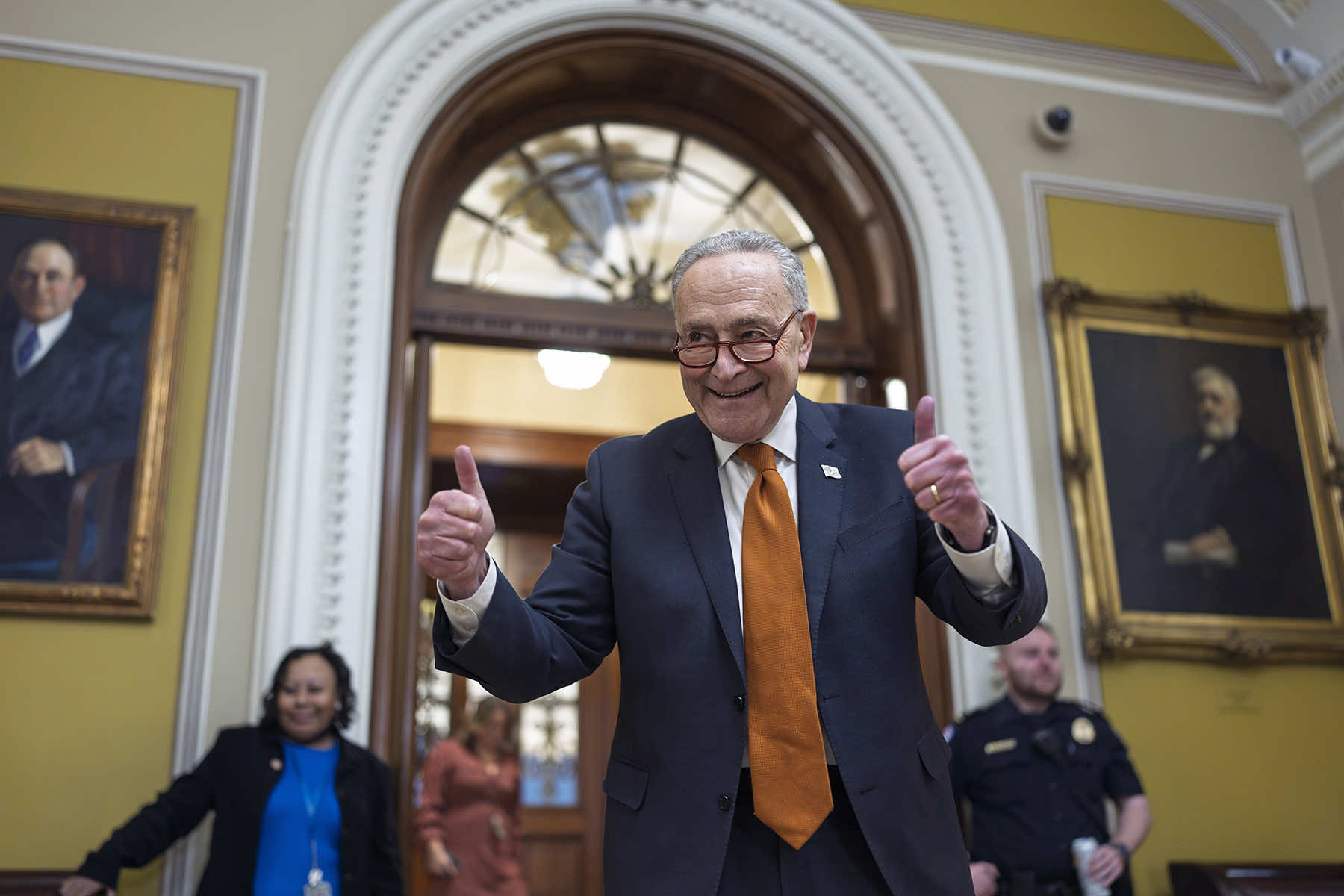
The House of Representatives passed a measure to fund the government for three months in the late hours of December 20. The measure will fund the government at current levels halfway through March.
It also appropriates $100 billion in disaster aid for regions hit by the storms and fires of the summer and fall, as well as $10 billion for farmers. Getting to this agreement has exposed the power vacuum in the Republican Party and thus a crisis in the government of the United States.
This fight over funding has been brewing since Republicans took over the House of Representatives in January 2023. From their first weeks in office, when they launched the longest fight over a House speaker since 1860, the Republicans were bitterly divided.
MAGA Republicans want to slash government so deeply that it will no longer be able to regulate business, provide a basic safety net, promote infrastructure, or protect civil rights. Establishment Republicans also want to cut the government, but they recognize that with Democrats in charge of the Senate and a Democratic president, they cannot get everything they want.
As Jacob Bogage of the “Washington Post” recounted, when the nation hit the debt ceiling in spring 2023, Republicans used it to demand that the Democrats cut the budget back to 2022 levels. Democrats objected that they had raised the debt ceiling without conditions three times under Trump and that Republicans had agreed to the budget to which the new Republicans were demanding cuts.
The debt ceiling is a holdover from World War I, when Congress stopped micromanaging the instruments the Treasury used to borrow money and instead simply set a debt limit. That procedure began to be a political weapon after the tax cuts first during President George W. Bush’s term and then under President Donald Trump reduced government revenues to 16.5% of the nation’s gross domestic product while spending has risen to nearly 23%. This gap means the country must borrow money to meet its budget appropriations, eventually hitting the ceiling.
The Treasury has never defaulted on the U.S. debt. A default would mean the government could not meet its obligations, and would, as Treasury Secretary Janet Yellen warned in 2023, “cause irreparable harm to the U.S. economy, the livelihoods of all Americans, and global financial stability.”
As journalist Borage recalled, when then–House speaker Kevin McCarthy agreed to raise the debt ceiling in June 2023 in exchange for the Fiscal Responsibility Act that kept the 2024 and 2025 budgets at 2022 levels, House extremists turned on him.
In September those extremists, led by then-representative Matt Gaetz (R-FL) threw McCarthy out of the speaker’s chair—the only time in American history that a party has thrown out its own speaker. Weeks later, the Republicans finally voted to make Mike Johnson (R-LA) speaker, but Johnson had to rely on Democratic votes to fund the government for fiscal year 2024.
For 2025, Johnson and the Republicans said they wanted more cuts than the Fiscal Responsibility Act set out, and even still, the extremists filled the appropriations bills with culture-wars poison pills. Johnson could not get any measures through the House, and instead kept the government operating with Democratic votes for continuing resolutions that funded the government first through September 30, and then through to December 20.
At the same time, a farm bill, which Congress usually passes every five years and which outlines the country’s agriculture and food policies including supplemental nutrition – formerly known as food stamps, expired in 2023 and has also been continued through temporary extensions.
On Tuesday, December 17, Johnson announced that Republican and Democratic congressional leaders had hashed out another bipartisan continuing resolution that kept spending at current levels through March 14 while also providing about $100 billion in disaster relief and about $10 billion in assistance for farmers.
It also raised congressional salaries and kicked the government funding deadline through March 14. With bipartisan backing, it seemed like a last-minute reprieve from a holiday government shutdown.
Extremist Republicans immediately opposed the measure, but this was not a surprise. There were likely enough Democratic votes to pass it without them.
What WAS a surprise was that on December 18, billionaire Elon Musk, who holds billions in federal contracts, frightened Republican lawmakers into killing the continuing resolution by appearing to threaten to fund primary challengers against those who voted for the resolution.
“Any member of the House or Senate who votes for this outrageous spending bill deserves to be voted out in 2 years!” he tweeted. Later, he added: “No bills should be passed Congress [sic] until Jan 20, when [Trump] takes office.”
Musk’s opposition appeared to shock President-elect Donald Trump into speaking up against the bill about thirteen hours after Musk’s first stand, when he and Vice President–elect J.D. Vance also came out against the measure.
But, perhaps not wanting to seem to be following in Musk’s wake, Trump then added a new and unexpected demand. He insisted that any continuing resolution raise or get rid of the debt ceiling throughout his term, although the debt ceiling is not currently an issue. Trump threatened to primary any Republican who voted for a measure that did not suspend the debt ceiling.
Trump’s demand highlighted that his top priority is not the budget deficit he promised during the campaign to cut by 33%, but rather freeing himself up to spend whatever he wishes: after all, he added about a quarter of the current national debt during his first term. He intends to extend his 2017 tax cuts after they expire in 2025, although the Congressional Budget Office estimates that those cuts will add $4.6 trillion to the deficit over the next ten years.
He has also called for the deportation of 11 million to 20 million undocumented immigrants and possibly others, at a cost estimate of $88 billion to $315 billion a year.
House Republicans killed the bipartisan bill and, on December 20, introduced a new bill, rewritten along the lines Musk and Trump had demanded. They had not shown it to Democrats. It cut out a number of programs, including $190 million designated for pediatric cancer research, but it included the $110 billion in disaster aid and aid to farmers. It also raised the debt ceiling for the next two years, during which Republicans will control Congress.
“All Republicans, and even the Democrats, should do what is best for our Country and vote ‘YES’ for this Bill, TONIGHT!” Trump wrote.
But extremist Republicans said no straight out of the box, and Democrats, who had not been consulted on the bill, wanted no part of it. Republicans immediately tried to blame the Democrats for the looming government shutdown. Ignoring that Musk had manufactured the entire crisis and that members of his own party refused to support the measure, Trump posted, “This is a Biden problem to solve, but if Republicans can help solve it, they will.”
Then, as Johnson went back to the drawing board, Musk posted on X his support for Germany’s Alternative für Deutschland (AfD) neo-Nazi party. This raised back to prominence Trump’s having spent November 5, Election Day, at Mar-a-Lago with members of AfD, who said they are hoping to be close with the incoming Trump administration.
Social media exploded with the realization that an unelected billionaire from South Africa who apparently supports fascism was able to intimidate Republican legislators into doing his bidding.
In recent days, Trump has threatened former representative Liz Cheney (R-WY) with prosecution for her work as a member of Congress and has sued the Des Moines Register for publishing a poll that was unfavorable to him before the November election.
Those actions are classic authoritarian moves to consolidate power, but to those not paying close attention they were perhaps less striking than the reality that Musk appears to have taken over for Trump as the incoming president.
As CNN’s Erin Burnett pointed out “the world’s richest man, right now, holding the country hostage,” Democrats worked to call attention to this crisis.
Representative Richard Neal (D-MA) said: “We reached an agreement … and a tweet changed all of it? Can you imagine what the next two years are going to be like if every time the Congress works its will and then there’s a tweet … from an individual who has no official portfolio who threatens members on the Republican side with a primary, and they succumb?”
The chair of the Senate Appropriations Committee, Patty Murray (D-WA), said she would stay in Washington DC, through Christmas “because we’re not going to let Elon Musk run the government. Put simply, we should not let an unelected billionaire rip away research for pediatric cancer so he can get a tax cut or tear down policies that help America outcompete China because it could hurt his bottom line. We had a bipartisan deal — we should stick to it. The American people do not want chaos or a costly government shutdown all because an unelected billionaire wants to call the shots.”
Republicans, too, seemed dismayed at Musk’s power. Representative Rich McCormick (R-GA) told CNN’s Kaitlan Collins: “Last time I checked, Elon Musk doesn’t have a vote in Congress. Now, he has influence and he’ll put pressure on us to do whatever he thinks the right thing is for him, but I have 760,000 people that voted for me to do the right thing for them. And that’s what matters to me.”
On December 20, the House passed a measure much like the one Musk and Trump had undermined, funding the government and providing the big-ticket disaster and farm relief but not raising or getting rid of the debt ceiling.
According to Jennifer Scholtes of Politico, Republican leadership tried to get party members on board by promising to raise the debt ceiling by $1.5 trillion early in 2025 while also cutting $2.5 trillion in “mandatory” spending, which covers Social Security, Medicare, Medicaid, and SNAP nutrition assistance.
The vote in the House was 366 to 34, with one abstention. The measure passed thanks to Democratic votes, with 196 Democrats voting ‘yes’ in addition to the 170 Republicans who voted ‘yes’ (because of the circumstances of its passage, the measure needed two-thirds of the House to vote ‘yes’).
No Democrats voted against the measure, while 34 Republicans abandoned their speaker to vote ‘no.’ As Jake Sherman of “Punchbowl News” wrote: “Dem[ocrat]s saved Republicans here.”
Democrats also kept the government functioning to help ordinary Americans.
The fiasco of the past few days is a political blow to Trump. Musk overshadowed him, and when Trump demanded that Republicans free him from the debt ceiling, they ignored him. Meanwhile, extremist Republicans are calling for Johnson’s removal, but it is unclear who could earn the votes to take his place.
And, since the continuing resolution extends only until mid-March, and the first two months of Trump’s term will undoubtedly be consumed with the Senate confirmation hearings for his appointees — some of whom are highly questionable — it looks like this chaos will continue into 2025.
The Senate passed the measure as expected just after midnight. Nonetheless, it appears that that chaos, and the extraordinary problem of an unelected billionaire who hails from South Africa calling the shots in the Republican Congress, will loom over the new year.
J. Scott Applewhite (AP), Jose Luis Magana (AP), and Brandon Bell (AP)
Letters from an Аmerican is a daily email newsletter written by Heather Cox Richardson, about the history behind today’s politics

















